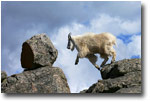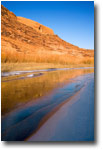Safety Considerations for Outdoor Photographers |
Most nature photographers enjoy the ephemeral escape afforded by wandering through wilderness areas near and far, away from the chaos of the city. We peer through viewfinders, absorbed in perfecting a composition and unaware of what is happening around us. We haul around hundreds or even thousands of dollars of valuable photography equipment. Our vehicles sit unattended at remote trailheads for hours on end. Though it isnít a pleasant thought, we are prime targets for criminal activity.
As a police officer and avid nature photographer, I utilize my law enforcement training and experience to ensure each trip into the wilderness is as safe as possible. In this article I will share several tips to help you stay safe while enjoying your photographic exploits in the great outdoors.
|
A safe wilderness experience begins with a little planning. Always tell someone where you are going and when you will return. Do a little research to determine what law enforcement agency has jurisdiction over the area you will be exploring and provide their contact information to friends, family or your significant other.
Statistics have shown that criminals more often prey upon targets traveling alone. Though we often go to the wilderness to escape being surrounded by people, it also makes us more vulnerable. Take a friend into the backcountry and your survival odds increase dramatically.
Trailheads are notorious for vehicle burglaries due to their often remote location and the lengthy period of time vehicles sit unattended while their owners are on the trail. Though there is no way to prevent a break-in there are things you can do to lessen the odds of it happening to you. Never leave valuables in plain sight. Stow your iPod in the glove box, carry your camera gear with you or leave what you donít need at home, and hide cdís, change and other valuable items out of sight. Another option is to consider installing a lockable system like those produced by Truck Vault.
A popular ploy used by many thieves is to hang out at the trailhead, act like another hiker and chat you up about your hiking plans. In telling them your plans you are also disclosing how long you will be away from your vehicle. Watch for anything out of the ordinary as you pull into the trailhead, be it a suspicious person or a window broken out of another vehicle. Always lock your car, regardless of whether you will be photographing a few feet or a few miles from your vehicle.
Studies have concluded that police officers who are in shape, maintain a neat uniform and act confidently are less likely to be involved in physical altercations. The same theory applies to citizens. Once you hit the trail donít be afraid to make eye contact with other hikers, walk tall and project confidence. You are less likely to be targeted by a criminal looking for easy prey.
Police officers are trained to be hyper aware of our surroundings at all times. Doing so helps prevent us from being surprised by an attack and allows us to provide detailed descriptions of suspects. Make a mental note of people you pass on the trail. What are they wearing? What color and length is their hair? How tall are they? Do they appear unusually nervous, fidgety or interested in you or your gear? Do they have anything on or around them that could be used as a weapon? Notice and remember these details in the unlikely event that you might need to act defensively.
While it is normal for non-photographers to be interested in your gear and ask questions about it, you should be cautious about discussing the monetary value of your equipment with strangers. Someone asking odd questions or who appears to be sizing up you and the environment might only be interested in making your camera, his camera. I was photographing mountain goats on Mt. Evans with a 100-400mm lens when a vehicle stopped on the road below me. The driver exited and slowly moved toward me. I assumed he was interested in seeing the goats from my vantage point until he reached my position and immediately began to ask questions about my gear. He said, "I bet thatís an expensive lens." I shrugged it off, saying "not really, there are lenses that cost 20 times as much!" Something about the man didnít sit right with me. I quickly packed up my equipment and walked back to my truck, all the while looking over my shoulder and listening for hurried footsteps behind me. Photo 1 was made before I had to unexpectedly depart. Was he viewing the goats and simply making small talk with me, or did he have other dubious intentions? I donít know, but I felt the safest thing to do was forsake additional photos and return to my vehicle.
As photographers we often find ourselves peering through viewfinders or with our heads under a dark cloth, completely oblivious to that which is happening around us. To a lion we would surely appear to be the weakest gazelle! Much of the joy I derive from photography comes from fine tuning compositions and losing myself in the moment. One need not forego this pleasure by constantly worrying about being attacked. Let your other senses pick up the slack while your eyes are busy. Listen for footsteps, be aware of changing odors and periodically lift your eye from the viewfinder to have a look around. You can quickly get back to the fun stuff once you determine there are no immediate threats.
For example, on a recent trip to photograph ice in the Colorado River north of Moab I discovered a homeless camp tucked into a thick stand of tamarisk. The camp appeared to be unoccupied but signs of recent activity were present. Patterns along the riverbank and towering cliffs reflecting in a thin layer of ice caught my attention. I set up my tripod and explored the photographic possibilities, all the while listening for any sounds of movement and occasionally lifting my eye from the viewfinder to survey my surroundings. Photo 2 was the result of this experience. I am not implying that all homeless are criminals. Nonetheless, many are mentally unstable and some are extremely territorial and have been known to attack "intruders."
It is highly unlikely that you will ever find yourself in a situation that calls for physical retaliation against an attacker. However, you should be mentally and physically prepared to defend yourself should such a situation arise. Cops are hammered in the academy to develop a "survival attitude." This consists of playing through hypothetical situations in your mind and deciding how you would react to them before they happen. In every situation it is critical that YOU come out the winner.
Most of us carry a dynamite weapon every time we go out; our tripod! Even a lightweight carbon fiber tripod will inflict serious injury upon an attacker. Other weapons are readily available in the wilderness, i.e. large stones and fallen tree branches. Be aware of what you have at your disposal so that you are prepared and can act swiftly to combat an attacker. However, you should only resort to physical force to defend yourself or another person from serious bodily harm. Should someone rob or attempt to rob you of gear or money your safest course of action is to simply hand it over to them. Your gear can be replaced. Photography and outdoor gear is usually covered under renterís or homeownerís insurance. Lastly, using physical force to defend property is rarely justified and you could be found criminally and civilly liable. Editorís note - New York exceptions for the justified use of physical force. Similar exceptions may exist in your state as well.
Since you located the name and contact information of local law enforcement before beginning your adventure, reporting suspicious activity will be a snap! Cops canít be everywhere at once. If you donít bother to report a suspicious incident, we have no way of knowing that a situation exists that requires our attention. You arenít bothering us and your report just might save someone else from becoming a victim.
Most importantly, follow your instincts. If something doesnít feel right it probably isnít. Donít let a single minded pursuit of photographic goals compromise your safety. Your "sixth sense" is usually accurate. Listen to it!
This article is not intended to scare you or to make you think twice about venturing into the wilderness. Rather, I only hope to make you more aware of what you can do to keep yourself safe while continuing to enjoy the peace and tranquility we all find through photography.
About the Author
Bret Edge has been photographing the American West for 8 years. He graduated from the Utah Peace Officers Standards and Training Academy in 2006 and is a Police Officer with the Moab City Police Department. Bretís adventure and nature photography can be seen at www.bretedge.com.
BE-NPN 0899
Comments on NPN nature photography safety articles? Send them to the editor.

